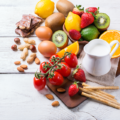Histamine intolerance

In one of our last posts we dealt extensively with the health consequences of fructose intolerance, and learned a lot in the process. We learned that around 20 to 30% of the European population is unable to digest sugars such as fructose, sorbitol or lactose.
The sad thing is that the condition cannot be treated with drugs. It’s not easy to arrive at a diagnosis of fructose intolerance. People often suffer symptoms for years and go through a marathon of doctor’s appointments before receiving the correct diagnosis.
The typical symptoms include flatulence, diarrhoea, constipation, headaches, bloated stomach, nausea, abdominal pain and cramps. Those affected have to avoid several foods for life.
Now we want to deal with another intolerance: histamine intolerance
Histamine is a protein that is found in certain foods, but is also produced by the body itself.
It is formed by the bacterial breakdown of the amino acid histidine, which is contained in certain foodstuffs. Spinach and tomatoes naturally contain histamine, as do animal-based foods such as fish, which are contaminated with the corresponding microorganisms. Foods that require fermentation in their production, such as cheese, sausage, sauerkraut, yeast extract, wine and beer, also contain histamine.
Histamine was first described pharmacologically in 1910 as a substance produced by the body itself. In 1932 it was identified as a mediator of allergic reactions. Histamine intolerance (histaminosis) can either be a congenital disorder, or can develop as a consequence of diseases of the gastrointestinal tract, drug intolerance or the build-up of toxins.
After eating food rich in histamine, people can suffer from various, often unspecific symptoms which are often similar to allergic reactions. Eighty percent of sufferers are middle-aged women. Exceeding the body’s own histamine tolerance threshold triggers histamine-mediated symptoms in these people. The strength of the symptoms depends on the concentration of histamine.
According to some authors, histamine intolerance is not a congenital condition, but an acquired disease that affects just under one to three percent of the European population. The accumulation of histamine in the body causes a range of symptoms, which can mostly be explained by the natural effects of histamine on blood vessels.
Bad news for sufferers
First, the bad news: histamine intolerance cannot be cured, just like congenital fructose intolerance.
At the moment, the only thing you can do is prove you suffer from the intolerance through an intestinal sample or a blood test. Histamine intolerance (HIT) is often viewed as an allergy, but it can also be considered a metabolic disorder.
The only treatment option is to change your diet.
Histamine intolerance is difficult to narrow down
The problem is that these symptoms also occur with many other intolerances and can therefore also point to other clinical pictures. The Institute for Microecology states the following: If the concentration of diamine oxidase in the blood is below three “units” per millilitre, doctors should assume the existence of a histamine intolerance.
The good news for sufferers is that vitamin C lowers histamine levels in the body. It can significantly lower histamine levels and relieve symptoms. Fresh fruit, especially apricots, shouldn’t cause problems for people with histamine intolerance. Apples are also a low-histamine fruit. According to the Institute for Nutritional Medicine at the Technical University of Munich, exceptions include pineapples, bananas, grapefruit, oranges, papaya, citrus fruits, kiwis, raspberries and strawberries.
Low-histamine foods
Low-histamine vegetables include various types of cabbage such as broccoli, kale, red cabbage and cauliflower, as well as cucumber, courgettes, potatoes, lettuce, fresh beetroot, onions, garlic and radishes. Some root vegetables are also low in histamine, including fennel, carrots, celeriac, parsnips, radishes, beetroot and black salsify. In addition, the following foods are also low in histamine: briefly matured cheeses such as cream cheese, butter cheese, cottage cheese, quark, mozzarella and ricotta, and grains such as rice, corn, quinoa, spelt, oats, amaranth and millet. Cooked meats such as boiled ham and sausages are also low in histamine, as is fresh white fish.
Foods to avoid if you are histamine intolerant
It’s not easy being histamine intolerant, as you can no longer eat what you like. Foods to avoid include longer-matured cheeses such as Camembert, Gouda, Parmesan, Emmental and Cheddar. Other foods rich in histamine include smoked products such as salami, cured ham and smoked or pickled fish. You should also avoid game, pork and offal, especially liver.
Products made from tomatoes are also a no-no for people with histamine intolerance. This includes tomato paste, pureed tomatoes, tomato ketchup and sun-dried tomatoes. You can, however, continue to eat fresh tomatoes in small quantities. Other high-histamine vegetables include sauerkraut, aubergine, spinach and avocado.
Alcohol and histamine intolerance don’t mix
Beer lovers should be careful, as beer is very rich in histamine. This includes all popular types of German beer, including Altbier, Kölsch, Berliner Weisse, Weizenbier, Hefeweizen, Zwickel, and Kellerbier. Alcohol-free beer is not histamine-free either. Red wine, champagne and sparkling wine are also naturally high in histamine, as are certain varieties of white wine. You should also avoid brandy and liqueurs.
But there is some good news if you don’t want to give up alcoholic beverages entirely: you can still enjoy a gin-and-tonic or a vodka-based drink. Little to no histamine is produced during the distillation of gin and vodka. What else can you drink if you are histamine intolerant? Water, juices and lemonades made from low-histamine fruits, herbal teas, almond milk, coconut milk and coconut water.
Beware of painkillers
People with a deficiency in the enzyme diamine oxidase, which causes histamine intolerance, can develop life-threatening reactions to certain drugs. Some painkillers can trigger a release of histamine.
A little goes a long way
White wine and sparkling wine contain significantly less histamine than red wine – on average less than 1 mg, while red wine typically contains three to four times as much. However, this doesn’t make a huge difference in the effect they can have. We are aware of people who, after half a glass of white wine in the evening, suffer from severe migraines the next day. Migraines like this can knock you out for a whole day, leaving you unable to work. Women suffer particularly.
We hope that you are not one of those affected!
Stay healthy!




